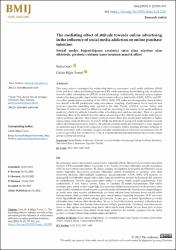The mediating effect of attitude towards online advertising in the influence of social media addiction on online purchase intention
Citation
Genç, R., & Bilgin Turna, G. (2023). The mediating effect of attitude towards online advertising in the influence of social media addiction on online purchase intention. Business & Management Studies: An International Journal, 11(2), 511–531. https://doi.org/10.15295/bmij.v11i2.2228Abstract
This study aims to investigate the relationship between consumers' social media addiction (SMA)
levels and their online purchasing intentions (OPI) while examining the mediating role of attitudes
towards online advertisements (ATOA) in this relationship. Additionally, the study aims to explore
whether the demographic characteristics of consumers influence their levels of SMA, ATOA, and OPI.
An online questionnaire consisting of the ATOA, SMA, OPI scales and demographic characteristics
was shared with 402 participants using convenience sampling. Confirmatory factor analysis and
structural equation modelling were applied to the data. T-tests, ANOVA, Levene, Tukey, and
Tamhane T2 tests were used for difference analysis. According to the results, social media addiction
positively affects the attitude towards online advertising and purchase intention. There is a partial
mediating effect of the attitude towards online advertising in the effect of social media addiction on
online purchase intention. Discriminant analysis results show that social media addiction is higher
among single students between 18 and 25. While the attitude of young and single students towards
online advertisements is more positive, the attitude towards online advertisements is more negative
in consumers aged 36 and over compared to other consumers. Online purchase intention is higher in
female consumers with a bachelor's degree or higher education level and lower in consumers over 36
years of age with a low-income level. Thus, it is recommended that practitioners focus on this target
group in online advertising. Bu çalışmanın amacı, tüketicilerin sosyal medya bağımlılık (SMA) düzeyleri ile çevrimiçi satın alma
niyetleri (OPI) arasındaki ilişkiyi incelemek ve bu ilişkide çevrimiçi reklamlara yönelik tutumların
(ATOA) aracı rolünü incelemektir. Ek olarak, çalışma, tüketicilerin demografik özelliklerinin sosyal
medya bağımlılık düzeylerini, çevrimiçi reklamlara yönelik tutumlarını ve çevrimiçi satın alma
niyetlerini etkileyip etkilemediğini araştırmayı amaçlamaktadır. ATOA, SMA, OPI ölçekleri ve
demografik özelliklerden oluşan online anket kolayda örnekleme yöntemi kullanılarak 402 katılımcı
ile paylaşılmıştır. Verilere, doğrulayıcı faktör analizi ve yapısal eşitlik modeli uygulanmıştır. Fark
analizlerinde, T testi, Anova, Levene, Tukey ve Tamhane T2 testleri kullanılmıştır. Elde edilen
sonuçlara göre, sosyal medya bağımlılığı, hem çevrimiçi reklama karşı tutumu hem de çevrimiçi satın
alma niyetini istatistiksel olarak anlamlı ve pozitif yönde etkilemektedir. Sosyal medya bağımlılığının
çevrimiçi satın alma niyetini etkilemesinde, çevrimiçi reklama karşı tutumun kısmi aracılık etkisi
bulunmaktadır. Fark analizleri sonucuna göre, sosyal medya bağımlılık düzeyinin 18-25 yaş arası,
bekâr öğrencilerde daha yüksek olduğu görülmüştür. Ayrıca, genç ve bekâr öğrencilerin çevrimiçi
reklamlara karşı tutumu daha olumlu iken, 36 yaş ve üzeri tüketicilerde çevrimiçi reklamlara karşı
tutumun diğer tüketicilere kıyasla daha olumsuz olduğu görülmüştür. Çevrimiçi satın alma niyeti;
lisans ve üstü eğitim seviyesine sahip kadın tüketicilerde daha yüksek, 36 yaş üzeri gelir seviyesi
düşük olan tüketicilerde daha düşük olarak tespit edilmiştir. Bu nedenle, uygulayıcılara bu hedef
grubun çevrimiçi reklamcılıkta odaklanmaları önerilebilir.


















